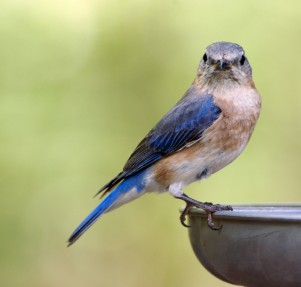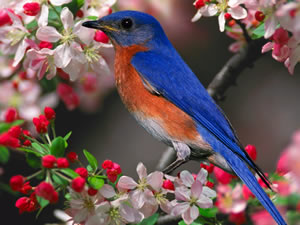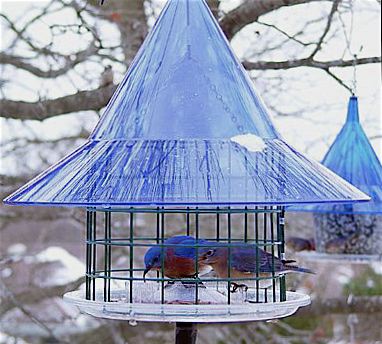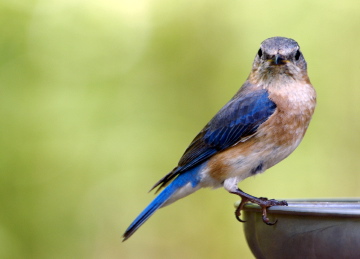-
The Mealworm Feeder New Year’s Resolution
Soooo guilty as charged below, ours gets stocked twice per day! Spoiled, spoiled birds- really isn’t the best scenario for them, it’s out of selfishness for simply wanting to observe. One 2015 resolution… lay off that mealworm feeder while weather remains mild and until there’s some nestlings for mom and dad to raise. The logic’s well explained below.
“WAY too many people worry about buying mealworms by the thousands, spending WAY too much money and feeding them normally at a time of the year when a healthy bluebird should be able to find WAY more than enough natural foods. Johnny Appleseed planted apple trees that were still producing fruit for many decades after he was gone! There are dozens, if not hundreds of species of plants in most areas that will provide fruits and or berries that bluebirds will feed on at different times of the year. Many/most of these are hardy enough that anyone could become an amateur “Johnny Appleseed” planting for wildlife in their own area. Keith Kridler Mt. Pleasant, Texas”
Bet you thought there would be all kinds of newfangled mealworm and bluebird feeders here? Nope! Almost weird how this info was received on the heels of discovering an article on Houzz, which was titled “Feed the Birds: 6 Plants for Abundant Winter Berries” by Therese Ciesinski.
These shrubs and trees not only enhance the landscape (the pics were stunning) they’ll offer birds natural food sources for years to come. Listing them here and tucking the list in my wallet for the future jaunts to the nursery!
- Winterberry
- Northern Bayberry
- Arrowood Viburnum
- Chokeberry
- Dogwood
- Crabapple
Looking back over 2014 and the small slice of heaven that is our habitat, it’s honestly helped to keep sane! A retreat, an escape, an unexplainable aspect of nature that calms, decompresses and relaxes the soul. A quote from Roger Tory Peterson sums it up pretty well: “The birds could very well live without us, but many-perhaps all-of us would find life incomplete, indeed almost intolerable without the birds.”
Wishing you and yours a happy and healthy 2015!
-
Innovative mealworm feeder
Waaay cool, the makers of the Sky Cafe have created a mealworm feeder specifically for bluebirds. The new Sky Cafe is totally squirrel proof for starters. The design will keep larger birds out, thus saving precious mealworms for your bluebirds. The large baffle, or hat, also protects food and birds from the elements. A high quality mealworm feeder that may be pole mounted or hung, you know will be around for many years of use and enjoyment
There are lots of groovy dish-type mealworm feeders out there, but as soon as birds discover the tasty morsels, the worms will disappear in no time flat! Seems lots of birds love mealworms… especially live ones.
If you’re forever running to the store in order to keep your mealworm feeder filled, you may want to consider buying them in bulk. It’s far more economical if you’re feeding live worms. Stored in the fridge, the worms stay in a dormant state until they’re warmed up, so no worries of creepy-crawly things in your fridge! The bedding used is nothing more than wheat bran, purchased at your local grocery store.
If you’ve been trying to attract bluebirds with no luck…live worms are the ticket! Bluebirds seem to find this precious food source quickly, and will stick around if mealworms are fed on a consistent basis. Our bluebirds have braved the tough winters of North Georgia for the past few years now… ever since their mealworm feeder is always stocked with live worms. The heated baths help too, and it’s got to be this combination that has allowed us to witness so many successful broods!
Here’s to spring!
- Bird Accessories, Bird Feeders, Bluebird Feeders, Fruit, Jelly & Mealworm Feeders, Live Meal Worms, Mealworm Feeder, Uncategorized
Try a Mealworm Feeder for Bluebirds
In order to entice bluebirds, sometimes their very favorite food must be offered. And meal worms happen to be what’s on the menu over here. Live mealworms are best, but dried or roasted ones will also work. One of the problems is that many species really enjoy mealworms, and you can find your supply dwindling quickly if fed in an open tray-type or dish feeder. Live mealworms are available in bulk quantities should this become habit forming too. They’re simple to store…just place in in a container in your fridge. Air holes are needed, but the worms stay in a dormant state until warmed up by the sun or room temperatures.
A mealworm feeder that’s made especially for bluebirds is one that is enclosed, in fact they’re called Bluebird Feeders. Consisting of two, four, or sometimes six entrances, they have clear acrylic panels for closures, and they’re meant for bluebirds only. Some feeders have a dish in the center for the worms, while others have a recessed circle for them. The birds must fly into the feeder to retrieve the worms, and very few species will try this. But somehow, the natural instinct of bluebirds tells them to do so.
It’s amazing to watch, especially when parent bring babies over at feeding time. At first the chicks don’t understand how to get inside, but they learn quickly. And once they learn how to get the food, they frequent the feeder often. This has got to be one of the best scenes of backyard birding!
Available in standard wooden models, mealworm feeders also come in recycled plastic versions. The advantage with
recycled plastic is that the feeder will never crack, split, or rot like wood tends to do over the years. Also keeping plastics out of landfills is huge plus to the environment.
Now I wish the nasty starling who tried to shove himself through one of the entrances would’ve gotten stuck there!






